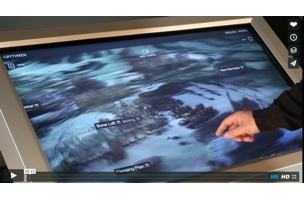In 2013 and 2014, the government of South Georgia and the Norwegian Directorate for Cultural Heritage commissioned a detailed LiDAR scanning survey of the remains of whaling stations on South Georgia. The results were one of the largest data sets in the world– measuring in at more than 10 billion points.
Using the Unity game engine, the team created an interactive presentation, which you can see below.
Here’s the full description from the video:
PROJECT BACKGROUND
Between 1904 and 1965 South Georgia served as a base for the Norwegian and British whaling fleets in the Antarctic Ocean. Permanent whaling bases were constructed at six sites across the island, where whalers and support staff endured both the harsh climate and dangerous working conditions to supply the world’s then huge demand for precious whale oil.
When whaling began to decline in the 1950’s the bases were gradually abandoned, with the last finally closing in 1965. As the surviving buildings are of corrugated metal construction, exposure to the severe weather of the region has accelerated a decline in both the fabric and safety of the structures in the fifty years since the sites closure. Many of the sites are now off-limits to tourist and visitors due to their poor structural condition and the possible presence of asbestos.
In the summers of 2013 and 2014, the Government of South Georgia and the Norwegian Directorate for Cultural Heritage commissioned a detailed LIDAR scanning survey of the remains of the whaling stations on South Georgia.
The scans carried out at the South Georgia Whaling sites are of some of the largest data sets in the world – upwards of 10 Billion points. A single Ascii scan file for one single station is often be as large as 1TB. This makes it too large for reliable ‘realtime’ manipulation, even by the current generation of commercial Lidar applications used by the scanning and survey teams. Due to the unwieldy nature of the dataset, it was to be placed in the archive of the British Antarctic Survey, until computing power advanced enough to make it accessible to the public.
PROJECT AIMS AND APPROACH
The application was designed allow visitors to explore selected Whaling Stations through the use of the Unity game engine, without the need or risk of visiting the actual sites. It’s main role is that of a time capsule, to provide a lasting repository for the stories of the whalers and their families that underwent such hardship at the very edge of the habitable world.
As many of the surviving whalers are now in their 70’s and 80’s, this represents one of the last opportunities for their eyewitness accounts to be captured and displayed to the wider public during their lifetimes.
The application is designed to allow users to navigate four whaling stations through large touchscreen interactive displays. The main navigation is constructed directly from the Lidar data with users able to move through the sets from a mixture of aerial and ground perspectives, exploring the sites in their own time and at their own pace by selecting sites and buildings that are of interest to them. Housed within key buildings are short films created from interviews with the whalers, film archive, and photos often that the whalers took themselves during their time on the island. Entering locations allows users to hear the whalers stories first-hand and see images of how the stations, ships and factories appeared during the height of the industry. Designing the application and its playback hardware together, allowed users to see interactive buildings chunks often at full 1:1 resolution – up to 50 Million points at 60 frames per second.
Shadow also designed and oversaw the manufacture of the computer hardware used to playback these huge data streams in realtime. They also oversaw the manufacture of the custom kiosk stands that were built in China. App design, production of the short films, and coding were all undertaken in-house as part of the project, along with all project production and management for both the Norwegian and British governments.
The exhibits are now on permanent display in three museums worldwide – the Fram Polar Expedition Museum in Oslo, the Whaling Museum at Sandefjord, and a special unit designed to withstand the harsh winter conditions at the Grytviken Museum, South Georgia.






